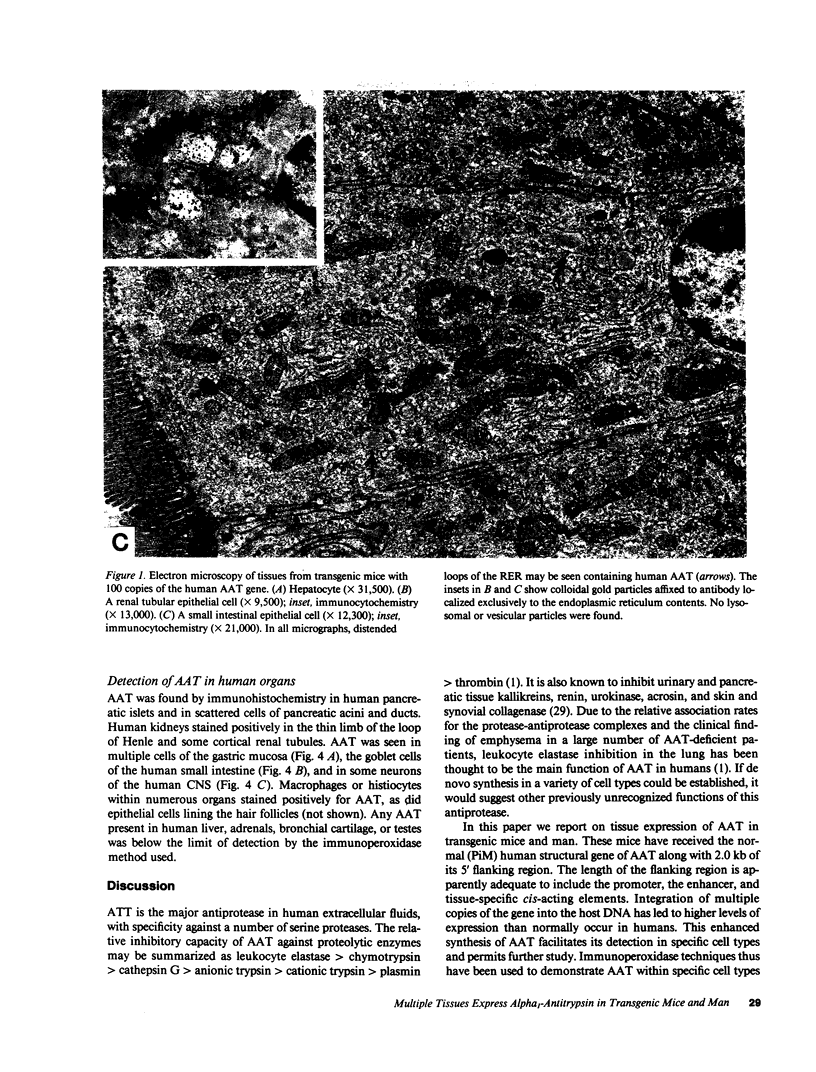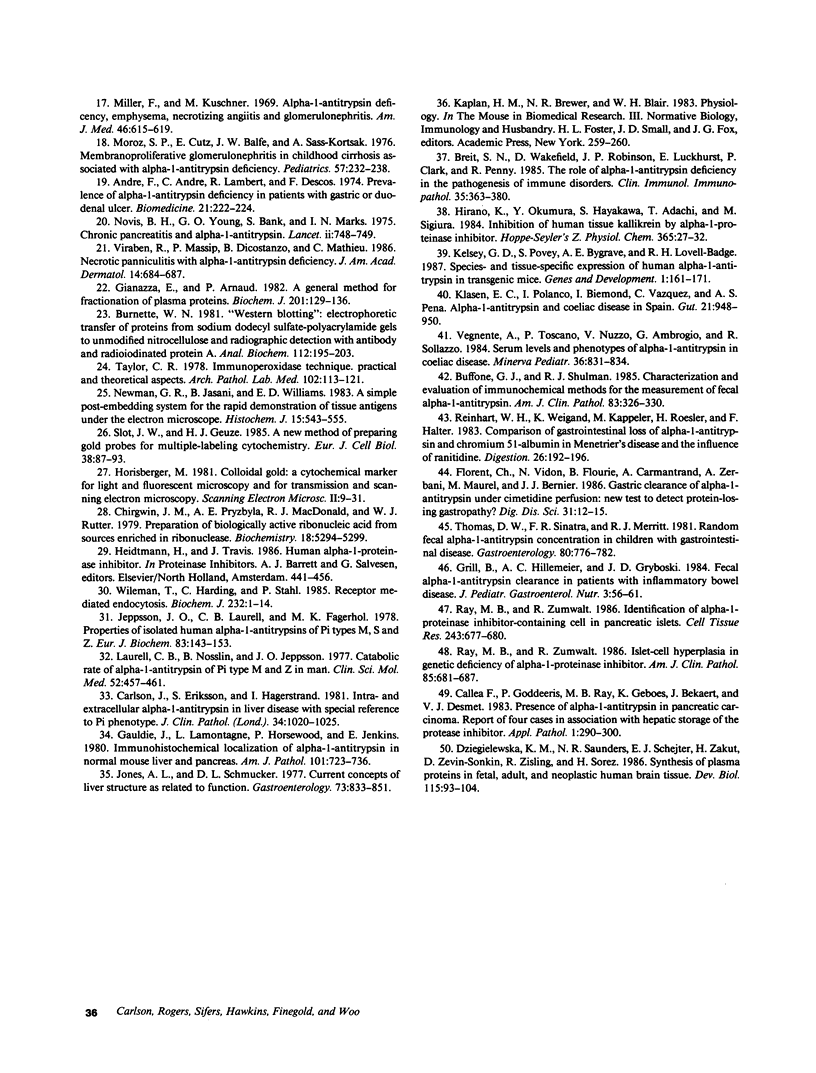Abstract
Hepatocytes are considered to be the predominant source of alpha 1-antitrypsin (AAT), the major antiprotease in human plasma. The development of emphysema in the hereditary PiZ AAT deficiency state suggests that inhibition of leukocyte elastase in the lung is a major function of this protein. In addition, patients with AAT deficiency are at increased risk for developing cholestasis in infancy and chronic liver disease as adults. The mechanism for hepatic cell injury, however, is not understood. Transgenic mice that express the normal human AAT gene demonstrate abundant AAT in hepatocytes and specific cell types of numerous nonhepatic tissues. Immunoperoxidase techniques have previously disclosed AAT in many of the cell types seen in transgenic mice; however, the issue of local synthesis vs. endocytosis in these cell types has remained unresolved. In this study, AAT mRNA was seen in a variety of tissues in the transgenic mouse. Immunoelectron microscopy of renal tubular and small intestinal epithelial cells in the transgenic mice demonstrated AAT within the cisternae of the rough endoplasmic reticulum, as in hepatocytes. These findings support the possibility of local synthesis in the various cell types. The results suggest that in addition to maintaining tissue integrity in the lung, the protease/antiprotease balance may have physiological functions in other organs as well.
Full text
PDF










Images in this article
Selected References
These references are in PubMed. This may not be the complete list of references from this article.
- Andre F., Andre C., Lambert R., Descos F. Prevalence of alpha1-antitrypsin deficiency in patients with gastric or duodenal ulcer. Biomedicine. 1974 May 20;21(5):222–224. [PubMed] [Google Scholar]
- Breit S. N., Wakefield D., Robinson J. P., Luckhurst E., Clark P., Penny R. The role of alpha 1-antitrypsin deficiency in the pathogenesis of immune disorders. Clin Immunol Immunopathol. 1985 Jun;35(3):363–380. doi: 10.1016/0090-1229(85)90097-2. [DOI] [PubMed] [Google Scholar]
- Buffone G. J., Shulman R. J. Characterization and evaluation of immunochemical methods for the measurement of fecal alpha 1-antitrypsin. Am J Clin Pathol. 1985 Mar;83(3):326–330. doi: 10.1093/ajcp/83.3.326. [DOI] [PubMed] [Google Scholar]
- Burnette W. N. "Western blotting": electrophoretic transfer of proteins from sodium dodecyl sulfate--polyacrylamide gels to unmodified nitrocellulose and radiographic detection with antibody and radioiodinated protein A. Anal Biochem. 1981 Apr;112(2):195–203. doi: 10.1016/0003-2697(81)90281-5. [DOI] [PubMed] [Google Scholar]
- Callea F., Goddeeris P., Mukunda R. B., Geboes K., Bekaert J., Desmet V. J. Presence of alpha-1-antitrypsin in pancreatic carcinoma. Report of four cases in association with hepatic storage of the protease inhibitor. Appl Pathol. 1983;1(5):290–300. [PubMed] [Google Scholar]
- Carlson J., Eriksson S., Hägerstrand I. Intra- and extracellular alpha 1-antitrypsin in liver disease with special reference to Pi phenotype. J Clin Pathol. 1981 Sep;34(9):1020–1025. doi: 10.1136/jcp.34.9.1020. [DOI] [PMC free article] [PubMed] [Google Scholar]
- Carlson J., Stenflo J. The biosynthesis of rat alpha 1-antitrypsin. J Biol Chem. 1982 Nov 10;257(21):12987–12994. [PubMed] [Google Scholar]
- Carrell R. W., Jeppsson J. O., Laurell C. B., Brennan S. O., Owen M. C., Vaughan L., Boswell D. R. Structure and variation of human alpha 1-antitrypsin. Nature. 1982 Jul 22;298(5872):329–334. doi: 10.1038/298329a0. [DOI] [PubMed] [Google Scholar]
- Chirgwin J. M., Przybyla A. E., MacDonald R. J., Rutter W. J. Isolation of biologically active ribonucleic acid from sources enriched in ribonuclease. Biochemistry. 1979 Nov 27;18(24):5294–5299. doi: 10.1021/bi00591a005. [DOI] [PubMed] [Google Scholar]
- Dziegielewska K. M., Saunders N. R., Schejter E. J., Zakut H., Zevin-Sonkin D., Zisling R., Soreq H. Synthesis of plasma proteins in fetal, adult, and neoplastic human brain tissue. Dev Biol. 1986 May;115(1):93–104. doi: 10.1016/0012-1606(86)90231-9. [DOI] [PubMed] [Google Scholar]
- Eriksson S., Carlson J., Velez R. Risk of cirrhosis and primary liver cancer in alpha 1-antitrypsin deficiency. N Engl J Med. 1986 Mar 20;314(12):736–739. doi: 10.1056/NEJM198603203141202. [DOI] [PubMed] [Google Scholar]
- Florent C., Vidon N., Flourié B., Carmantrand A., Zerbani A., Maurel M., Bernier J. J. Gastric clearance of alpha-1-antitrypsin under cimetidine perfusion. New test to detect protein-losing gastropathy? Dig Dis Sci. 1986 Jan;31(1):12–15. doi: 10.1007/BF01347903. [DOI] [PubMed] [Google Scholar]
- Gauldie J., Lamontagne L., Horsewood P., Jenkins E. Immunohistochemical localization of alpha 1-antitrypsin in normal mouse liver and pancreas. Am J Pathol. 1980 Dec;101(3):723–736. [PMC free article] [PubMed] [Google Scholar]
- Geboes K., Ray M. B., Rutgeerts P., Callea F., Desmet V. J., Vantrappen G. Morphological identification of alpha-I-antitrypsin in the human small intestine. Histopathology. 1982 Jan;6(1):55–60. doi: 10.1111/j.1365-2559.1982.tb02701.x. [DOI] [PubMed] [Google Scholar]
- Gianazza E., Arnaud P. A general method for fractionation of plasma proteins. Dye-ligand affinity chromatography on immobilized Cibacron blue F3-GA. Biochem J. 1982 Jan 1;201(1):129–136. doi: 10.1042/bj2010129. [DOI] [PMC free article] [PubMed] [Google Scholar]
- Grill B. B., Hillemeier A. C., Gryboski J. D. Fecal alpha 1-antitrypsin clearance in patients with inflammatory bowel disease. J Pediatr Gastroenterol Nutr. 1984;3(1):56–61. doi: 10.1097/00005176-198401000-00013. [DOI] [PubMed] [Google Scholar]
- Hirano K., Okumura Y., Hayakawa S., Adachi T., Sugiura M. Inhibition of human tissue kallikrein by alpha 1-proteinase inhibitor. Hoppe Seylers Z Physiol Chem. 1984 Jan;365(1):27–32. doi: 10.1515/bchm2.1984.365.1.27. [DOI] [PubMed] [Google Scholar]
- Horisberger M. Colloidal gold : a cytochemical marker for light and fluorescent microscopy and for transmission and scanning electron microscopy. Scan Electron Microsc. 1981;(Pt 2):9–31. [PubMed] [Google Scholar]
- Jeppsson J. O., Laurell C. B., Fagerhol M. Properties of isolated human alpha1-antitrypsins of Pi types M, S and Z. Eur J Biochem. 1978 Feb 1;83(1):143–153. doi: 10.1111/j.1432-1033.1978.tb12078.x. [DOI] [PubMed] [Google Scholar]
- Jones A. L., Schmucker D. L. Current concepts of liver structure as related to function. Gastroenterology. 1977 Oct;73(4 Pt 1):833–851. [PubMed] [Google Scholar]
- Kelsey G. D., Povey S., Bygrave A. E., Lovell-Badge R. H. Species- and tissue-specific expression of human alpha 1-antitrypsin in transgenic mice. Genes Dev. 1987 Apr;1(2):161–171. doi: 10.1101/gad.1.2.161. [DOI] [PubMed] [Google Scholar]
- Kittas C., Aroni K., Matani A., Papadimitriou C. S. Immunocytochemical demonstration of a1-Antitrypsin and a1-Antichymotrypsin in human gastrointestinal tract. Hepatogastroenterology. 1982 Dec;29(6):275–277. [PubMed] [Google Scholar]
- Laurell C. B., Nosslin B., Jeppsson J. O. Catabolic rate of alpha1-antitrypsin of Pi type M and Z in man. Clin Sci Mol Med. 1977 May;52(5):457–461. doi: 10.1042/cs0520457. [DOI] [PubMed] [Google Scholar]
- Miller F., Kuschner M. Alpha1-antitrypsin deficiency, emphysema, necrotizing angiitis and glomerulonephritis. Am J Med. 1969 Apr;46(4):615–623. doi: 10.1016/0002-9343(69)90080-1. [DOI] [PubMed] [Google Scholar]
- Mornex J. F., Chytil-Weir A., Martinet Y., Courtney M., LeCocq J. P., Crystal R. G. Expression of the alpha-1-antitrypsin gene in mononuclear phagocytes of normal and alpha-1-antitrypsin-deficient individuals. J Clin Invest. 1986 Jun;77(6):1952–1961. doi: 10.1172/JCI112524. [DOI] [PMC free article] [PubMed] [Google Scholar]
- Moroz S. P., Cutz E., Balfe J. W., Sass-Kortsak A. Membranoproliferative glomerulonephritis in childhood cirrhosis associated with alpha1-antitrypsin deficiency. Pediatrics. 1976 Feb;57(2):232–238. [PubMed] [Google Scholar]
- Newman G. R., Jasani B., Williams E. D. A simple post-embedding system for the rapid demonstration of tissue antigens under the electron microscope. Histochem J. 1983 Jun;15(6):543–555. doi: 10.1007/BF01954145. [DOI] [PubMed] [Google Scholar]
- Nielsen K. Coeliac disease: alpha-1-antitrypsin contents in jejunal mucosa before and after gluten-free diet. Histopathology. 1984 Sep;8(5):759–764. doi: 10.1111/j.1365-2559.1984.tb02392.x. [DOI] [PubMed] [Google Scholar]
- Novis B. H., Young G. O., Bank S., Marks I. N. Chronic pancreatitis and alpha-1-antitrypsin. Lancet. 1975 Oct 18;2(7938):748–749. doi: 10.1016/s0140-6736(75)90728-x. [DOI] [PubMed] [Google Scholar]
- Perlmutter D. H., Cole F. S., Kilbridge P., Rossing T. H., Colten H. R. Expression of the alpha 1-proteinase inhibitor gene in human monocytes and macrophages. Proc Natl Acad Sci U S A. 1985 Feb;82(3):795–799. doi: 10.1073/pnas.82.3.795. [DOI] [PMC free article] [PubMed] [Google Scholar]
- Ray M. B., Desmet V. J., Gepts W. alpha-1-Antitrypsin immunoreactivity in islet cells of adult human pancreas. Cell Tissue Res. 1977 Nov 30;185(1):63–68. doi: 10.1007/BF00226668. [DOI] [PubMed] [Google Scholar]
- Ray M. B., Geboes K., Callea F., Desmet V. J. Alpha-1-antitrypsin immunoreactivity in gastric carcinoid. Histopathology. 1982 May;6(3):289–297. doi: 10.1111/j.1365-2559.1982.tb02723.x. [DOI] [PubMed] [Google Scholar]
- Ray M. B., Zumwalt R. E. Identification of alpha-1-proteinase inhibitor-containing cells in pancreatic islets. Cell Tissue Res. 1986;243(3):677–680. doi: 10.1007/BF00218078. [DOI] [PubMed] [Google Scholar]
- Ray M. B., Zumwalt R. Islet-cell hyperplasia in genetic deficiency of alpha-1-proteinase inhibitor. Am J Clin Pathol. 1986 Jun;85(6):681–687. doi: 10.1093/ajcp/85.6.681. [DOI] [PubMed] [Google Scholar]
- Reinhart W. H., Weigand K., Kappeler M., Roesler H., Halter F. Comparison of gastrointestinal loss of alpha-1-antitrypsin and chromium-51-albumin in Ménétrier's disease and the influence of ranitidine. Digestion. 1983;26(4):192–196. doi: 10.1159/000198889. [DOI] [PubMed] [Google Scholar]
- Sharp H. L., Bridges R. A., Krivit W., Freier E. F. Cirrhosis associated with alpha-1-antitrypsin deficiency: a previously unrecognized inherited disorder. J Lab Clin Med. 1969 Jun;73(6):934–939. [PubMed] [Google Scholar]
- Sifers R. N., Carlson J. A., Clift S. M., DeMayo F. J., Bullock D. W., Woo S. L. Tissue specific expression of the human alpha-1-antitrypsin gene in transgenic mice. Nucleic Acids Res. 1987 Feb 25;15(4):1459–1475. doi: 10.1093/nar/15.4.1459. [DOI] [PMC free article] [PubMed] [Google Scholar]
- Slot J. W., Geuze H. J. A new method of preparing gold probes for multiple-labeling cytochemistry. Eur J Cell Biol. 1985 Jul;38(1):87–93. [PubMed] [Google Scholar]
- Tahara E., Ito H., Taniyama K., Yokozaki H., Hata J. Alpha 1-antitrypsin, alpha 1-antichymotrypsin, and alpha 2-macroglobulin in human gastric carcinomas: a retrospective immunohistochemical study. Hum Pathol. 1984 Oct;15(10):957–964. doi: 10.1016/s0046-8177(84)80125-2. [DOI] [PubMed] [Google Scholar]
- Taylor C. R. Immunoperoxidase techniques: practical and theoretical aspects. Arch Pathol Lab Med. 1978 Mar;102(3):113–121. [PubMed] [Google Scholar]
- Thomas D. W., Sinatra F. R., Merritt R. J. Random fecal alpha-1-antitrypsin concentration in children with gastrointestinal disease. Gastroenterology. 1981 Apr;80(4):776–782. [PubMed] [Google Scholar]
- Vegnente A., Toscano P., Nuzzo V., Ambrogio G., Sollazzo R. Livelli sierici e fenotipi di alpha 1 antitripsina nella malattia celiaca del bambino e dell'adulto in Campania. Minerva Pediatr. 1984 Sep 15;36(17):831–834. [PubMed] [Google Scholar]
- Viraben R., Massip P., Dicostanzo B., Mathieu C. Necrotic panniculitis with alpha-1 antitrypsin deficiency. J Am Acad Dermatol. 1986 Apr;14(4):684–687. doi: 10.1016/s0190-9622(86)80466-2. [DOI] [PubMed] [Google Scholar]
- Wileman T., Harding C., Stahl P. Receptor-mediated endocytosis. Biochem J. 1985 Nov 15;232(1):1–14. doi: 10.1042/bj2320001. [DOI] [PMC free article] [PubMed] [Google Scholar]

















